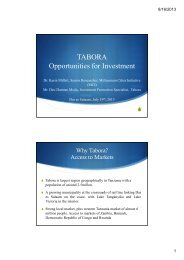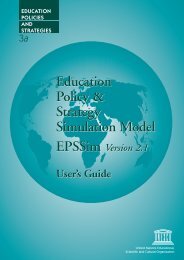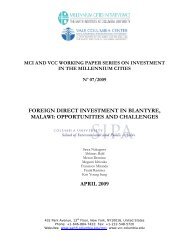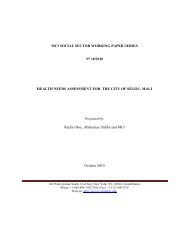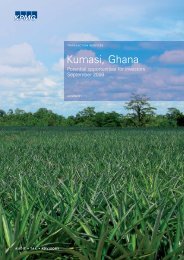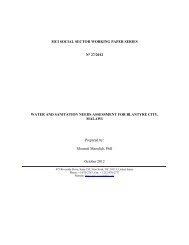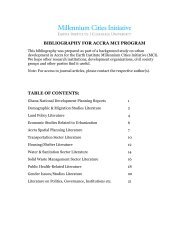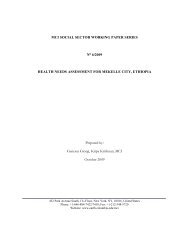Health Needs Assessment for Kisumu, Kenya - Millennium Cities ...
Health Needs Assessment for Kisumu, Kenya - Millennium Cities ...
Health Needs Assessment for Kisumu, Kenya - Millennium Cities ...
You also want an ePaper? Increase the reach of your titles
YUMPU automatically turns print PDFs into web optimized ePapers that Google loves.
EXECUTIVE SUMMARY<br />
<strong>Kisumu</strong>, the capital of Nyanza Province in western <strong>Kenya</strong>, was designated as a <strong>Millennium</strong> City<br />
by the Earth Institute at Columbia University in 2006. The city is struggling to reduce high<br />
maternal and child mortality rates and faces numerous other health challenges, including high<br />
rates of malaria and HIV prevalence, lack of qualified health workers and a dilapidated health<br />
infrastructure. Poor access to health services, clean water and sanitation facilities also<br />
contributes to the high burden of ill-health in the city.<br />
The infant mortality rate (IMR) in <strong>Kisumu</strong> in 2008 was 123 per 1,000 live births, the under-five<br />
mortality rate (U5MR) was 220 per 1,000 live births. These indicators are symptomatic of<br />
generally poor health status and are much higher than the national IMR and U5MR (52/1000 and<br />
74/1000 respectively). However, there are indications that ef<strong>for</strong>ts to provide children under-five<br />
with bed nets to protect them against mosquitoes that spread malaria, to reduce diarrhea and to<br />
increase immunization coverage are contributing to improvements in child mortality in <strong>Kisumu</strong><br />
and throughout <strong>Kenya</strong>. Additional measures that can enhance child survival include reducing<br />
neonatal deaths and encouraging breast-feeding <strong>for</strong> the first six months of a baby’s life.<br />
The maternal mortality ratio (MMR) in <strong>Kisumu</strong> was estimated to be around 456 per 100,000 live<br />
births in 2008. Even though this ratio is lower than <strong>Kenya</strong>’s MMR of 488 deaths per 100,000<br />
live births, it could be drastically lowered by improving access to basic antenatal and emergency<br />
obstetric care and increasing the proportion of women who deliver with skilled health attendants.<br />
In 2008, only 30 percent of women in <strong>Kisumu</strong> completed four antenatal visits and only 33.3<br />
percent of births were attended by a skilled health professional. Contraceptive prevalence is also<br />
low (27 percent). Improving access to family planning services and continuing to provide<br />
intermittent malaria prophylaxis and insecticide-treated nets to pregnant women can play a<br />
critical role in improving maternal health outcomes.<br />
Malaria remains a leading cause of outpatient morbidity in <strong>Kisumu</strong>, and the HIV prevalence rate<br />
in <strong>Kisumu</strong> (15 percent) is more than double the national prevalence rate of 7.4 percent. Other<br />
common illnesses include diarrhea and respiratory diseases. The city there<strong>for</strong>e needs to scale up<br />
malaria and HIV interventions and to promote both oral rehydration therapy <strong>for</strong> diarrhea and<br />
antibiotics <strong>for</strong> respiratory diseases.<br />
During the next two years (2011-12), the health sector in <strong>Kisumu</strong> will focus on preventive health<br />
care, with emphasis on the control of communicable and non-communicable diseases and<br />
reproductive and child health services. However, there is also a need to expand the training of<br />
physicians and nurses. MCI estimates that <strong>Kisumu</strong> can achieve the health-related MDGs with an<br />
average annual per capita investment of $27 per annum between 2011 and 2015.<br />
This report is organized as follows: an introduction reviews the methodology used and<br />
limitations in conducting the research; this is followed by a description of the structure of<br />
<strong>Kisumu</strong>’s health care system, an analysis of major health challenges and an outline of costs<br />
necessary to attain the three health-related MDGs. The conclusion synthesizes the findings and<br />
presents some recommendations.<br />
7



